No actually there were several ahead of it.
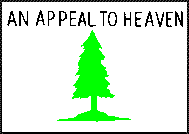 |
American ships in New England waters flew a "Liberty Tree" flag in 1775. It shows a green pine tree on a white background. |
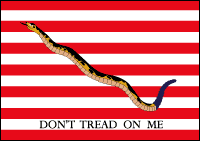 |
The Continental Navy used this flag upon its inception. |
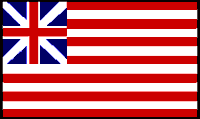 |
The "Grand Union" shown here is also called The "Cambridge Flag." It was flown over Prospect Hill, overlooking Boston, January 1, 1776. In the canton (the square in the corner) are the crosses of Saint Andrew and Saint George, borrowed from the British flag. |
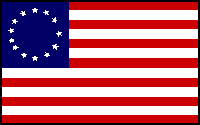 |
The "Betsy Ross" flag. |
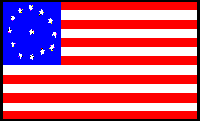 |
According to some sources, this flag was first used in 1777. It was used by the Third Maryland Regiment. There was no official pattern for how the stars were to be arranged. The flag was carried at the Battle of Cowpens, which took place on January 17, 1781, in South Carolina. The actual flag from that battle hangs in the Maryland State House. |
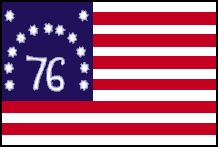 At the Battle of Bennington in August 1777 were two famous flags. One, shown here, is called the Bennington Flag or the Fillmore Flag. Nathaniel Fillmore took this flag home from the battlefield. The flag was passed down through generations of Fillmores, including Millard, and today it can be seen at Vermont's Bennington Museum. The other (not pictured) has a green field and a blue canton with 13 gold-painted stars arranged in rows. General John Stark gave his New Hampshire troops a rallying speech that would be the envy of any football coach today. He said, "My men, yonder are the Hessians. They were brought for seven pounds and ten pence a man. Are you worth more? Prove it. Tonight, the American flag floats from yonder hill or Molly Stark sleeps a widow!" Image courtesy of Ed Jones. At the Battle of Bennington in August 1777 were two famous flags. One, shown here, is called the Bennington Flag or the Fillmore Flag. Nathaniel Fillmore took this flag home from the battlefield. The flag was passed down through generations of Fillmores, including Millard, and today it can be seen at Vermont's Bennington Museum. The other (not pictured) has a green field and a blue canton with 13 gold-painted stars arranged in rows. General John Stark gave his New Hampshire troops a rallying speech that would be the envy of any football coach today. He said, "My men, yonder are the Hessians. They were brought for seven pounds and ten pence a man. Are you worth more? Prove it. Tonight, the American flag floats from yonder hill or Molly Stark sleeps a widow!" Image courtesy of Ed Jones. |
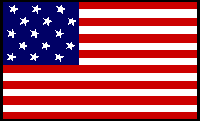 |
Vermont and Kentucky joined the union in 1791 and 1792. This flag with 15 stars and 15 stripes, was adopted by a Congressional act of 1794. The flag became effective May 1, 1795. |
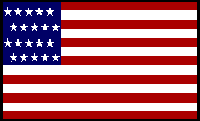 |
By 1818, the union consisted of 20 states. A Congressional act mandated that the number of stripes be fixed at 13 and that one new star was to be added for each new state, the July 4 following its admission. However, nothing was written about what arrangement the stars should be in. This and the following two flags were all used simultaneously. |
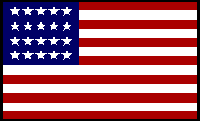 |
Another 1818 flag (see above). |
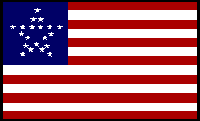 |
And another 1818 flag (see above). This was called the "Grand Star" flag. |
 |
Following the Mexican-American War in 1846, the nation had 28 states. |
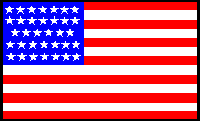 |
By 1861, the nation had 34 states. Even after the South seceded from the Union, President Lincoln would not allow any stars to be removed from the flag. |
 |
In 1908, the United States had 46 states. It's interesting to note that there was no official design for the 46-star flag used from 1908 to 1912. |
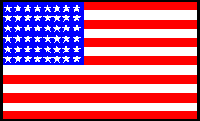 |
In 1912, the United States had 48 states. A Presidential order was issued fixing the position of the stars for this flag. Presidential orders followed the adoption of the flags of 1959 and 1960, as well. |
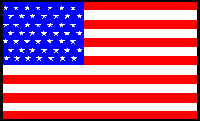 |
This flag was used starting on July 4, 1959, after the admission of Alaska to the Union on Jan. 3, 1959. |
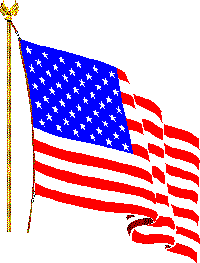 |
The United States flag today. The 50th star was added on July 4, 1960 for Hawaii, which entered the Union on August 21, 1959. |
 The first American flag design ? I developed this design based on several Continental Artillery officer belt tips that were excavated from circa 1779 Revolutionary War archaeological sites in New Jersey and New York. These hand engraved belt tips were made by a Philadelphia silversmith during the early part of 1779 during a visit to the encampment of Knox's Artillery Corps at Pluckemin, New Jersey. They are the earliest documented artifacts to clearly show the traditional flag of the United States. All of the known belt tip examples clearly show a star orientation of five over three over five. The actual star design is suppositional. I based it on flag designs shown in several Revolutionary War period paintings which use the six pointed star instead of the customary five pointed version. It is also believed that Washington himself preferred the six pointed star as part of the flag design and used these on his headquarters flag.
The first American flag design ? I developed this design based on several Continental Artillery officer belt tips that were excavated from circa 1779 Revolutionary War archaeological sites in New Jersey and New York. These hand engraved belt tips were made by a Philadelphia silversmith during the early part of 1779 during a visit to the encampment of Knox's Artillery Corps at Pluckemin, New Jersey. They are the earliest documented artifacts to clearly show the traditional flag of the United States. All of the known belt tip examples clearly show a star orientation of five over three over five. The actual star design is suppositional. I based it on flag designs shown in several Revolutionary War period paintings which use the six pointed star instead of the customary five pointed version. It is also believed that Washington himself preferred the six pointed star as part of the flag design and used these on his headquarters flag.




 At the Battle of Bennington in August 1777 were two famous flags. One, shown here, is called the Bennington Flag or the Fillmore Flag. Nathaniel Fillmore took this flag home from the battlefield. The flag was passed down through generations of Fillmores, including Millard, and today it can be seen at Vermont's Bennington Museum. The other (not pictured) has a green field and a blue canton with 13 gold-painted stars arranged in rows. General John Stark gave his New Hampshire troops a rallying speech that would be the envy of any football coach today. He said, "My men, yonder are the Hessians. They were brought for seven pounds and ten pence a man. Are you worth more? Prove it. Tonight, the American flag floats from yonder hill or Molly Stark sleeps a widow!" Image courtesy of
At the Battle of Bennington in August 1777 were two famous flags. One, shown here, is called the Bennington Flag or the Fillmore Flag. Nathaniel Fillmore took this flag home from the battlefield. The flag was passed down through generations of Fillmores, including Millard, and today it can be seen at Vermont's Bennington Museum. The other (not pictured) has a green field and a blue canton with 13 gold-painted stars arranged in rows. General John Stark gave his New Hampshire troops a rallying speech that would be the envy of any football coach today. He said, "My men, yonder are the Hessians. They were brought for seven pounds and ten pence a man. Are you worth more? Prove it. Tonight, the American flag floats from yonder hill or Molly Stark sleeps a widow!" Image courtesy of 








